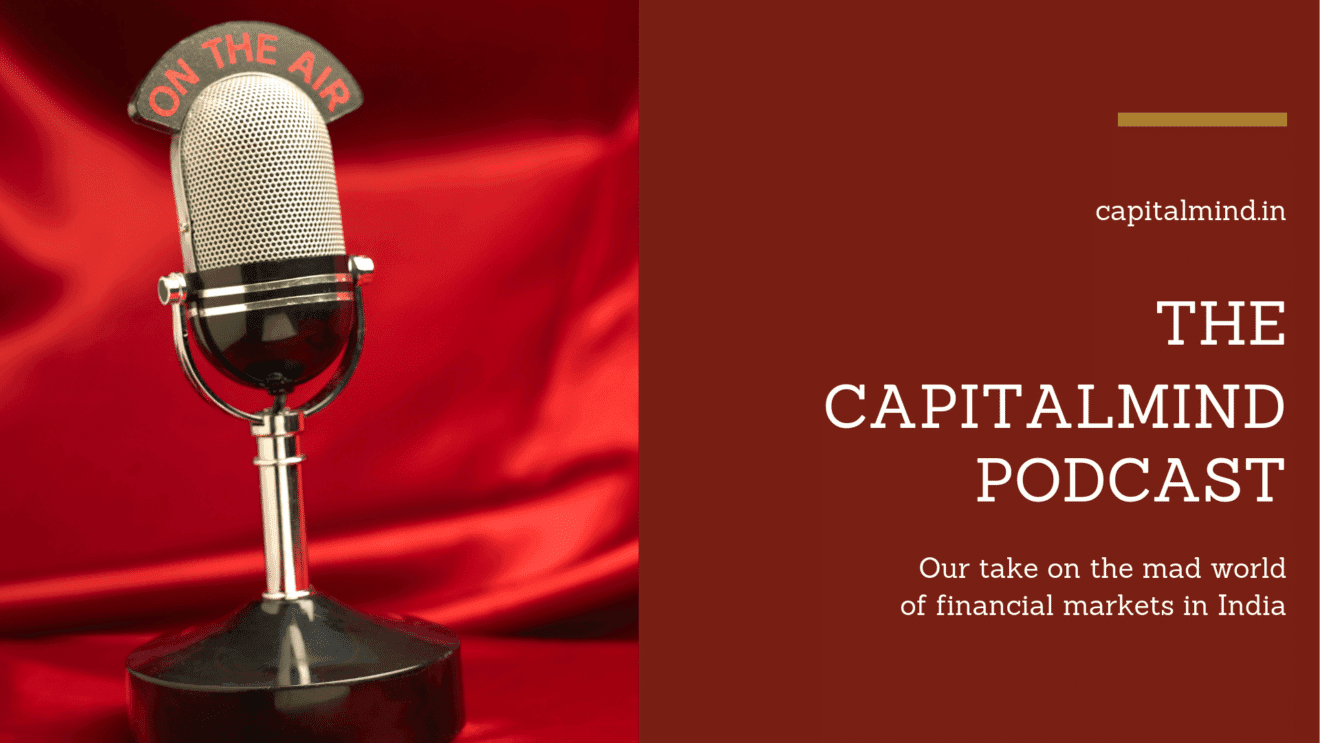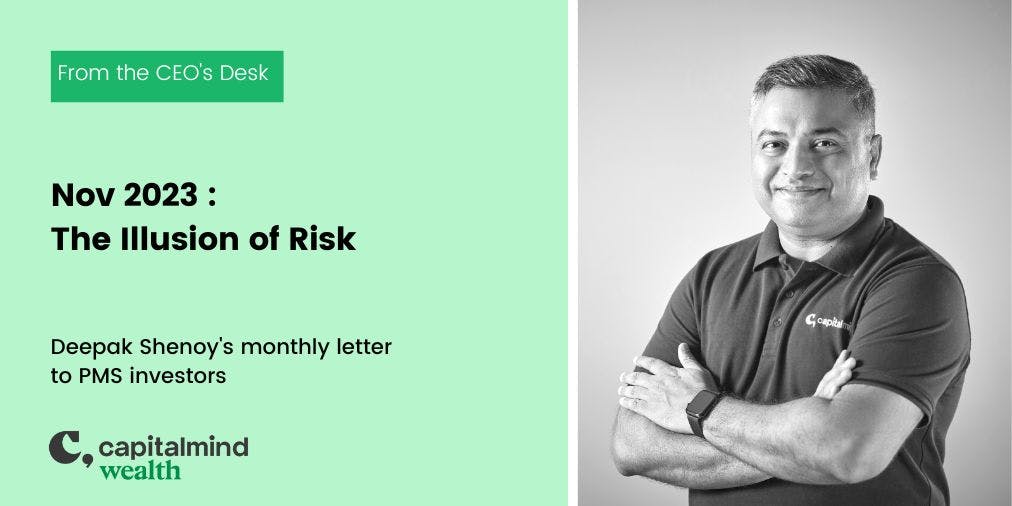(category)Economy
Podcast Episode 2: Are Index Funds Outperforming Actively Managed Funds?Podcast Episode 2: Are Index Funds Outperforming Actively Managed Funds?
Deepak Shenoy•

We had a good response to our first episode: (Episode 1: On Debt Funds Losing Money). Today we bring you Episode 2.
It's about a topic that's interesting for us as active participants: Are Index Funds outperforming Actively Managed Funds?
Listen in, click the play button below.
Deepak Shenoy and Shray Chandra discuss the potential of "passive" investing.
1.Index Funds starting to hold their own?
- Index like products more popular in markets like the US
- Slowly coming of age in India
- Actively managed large cap mutual funds
- Want exposure to top 100 stocks, put 50% of funds in say nifty 50 and 50% of funds in nifty next 50
- Are actively managed large cap funds beating this combination?
- Combination of Nifty50 and Nifty Next 50 has beaten large cap funds on 3,5 and 10 year period!
- 2-3% p.a underperformance over the past few years.
2.Are fees responsible for mutual fund underperformance
- Index are in a loose sense momentum type products
- 80-85% of MF money goes into large caps and large cap oriented funds
- SEBI regulations on limiting the universe of stocks per mutual fund does make outperformance more difficult
- Fees do play a part but they're not the whole picture
- Index management through derivates and algorithms
- Nifty Next 50 has fallen considerably more than the Nifty
- SBI Nifty ETF gets significant monthly inflows from EPFO
- Information arbitrage on these large cap names isn't what it used to be (this is a good thing)
3.What does this mean for customers?
- There can be a point at which passive investing leads to problems but we're nowhere near that
- Bank of Japan ETF purchases are an example where corporate governance issues don't necessarily bring down a stock
- Index investing means Less decision fatigue for customers
- Can spend less than an hour a year to see if index funds are winning out
Parting thoughts:
- They are 100+ index type funds too. So there's scope for innovation and marketing in indexes.
- Indexing is here. It's worth considering.
- If you have a demat account, the SBI Nifty 50 ETF is the big index product out there.
We'll have a more detailed post with data and charts soon!
Transcript:
Shray: Hi everyone. Welcome to episode two of the Capitalmind show. Thanks for the great feedback and responses to the first episode. And we have quite a head spinner this time. So, Deepak, index funds ... Is this really happening? Are index funds now beating mutual funds? And do we now need to consider removing the slogan Active Investing from our logo on the office?
Deepak: say ... I think, you know, we've already started to remove it very quietly. The new office doesn't seem to have the phrase Active Investing. We're probably getting over it, probably inadvertently, but here's what the data's telling us, okay? So there has been a lot of index funds or index products over the years in the US and in other places. In India, they haven't been very popular but they've slowly started to gain acceptance. You've seen index ETFs, index funds and other such things that actually work on the index itself. A huge amount of opportunity seems to be wasted in terms of people putting money into actively managed large cap mutual funds versus the large cap indexes.
I say that by basically looking at the NIFTY 50 and the NIFTY Next 50. I don't say that every fund is underperforming the NIFTY 50, or the NIFTY Next 50, but here's a simple thing. You want access to the top 100, what are you going to do? You're going to buy the NIFTY 50 and then you're going to buy the NIFTY Next 50. Probably separately because you don't have an index fund very easily available on the NIFTY 100. So you would put half your money in the NIFTY 50, say a mutual fund or an index fund, and another half on the NIFTY Next 50 index fund. A smart beta product, if you may. Let's see with this combination I thought; let's look at data over the last 10 years and see if active funds, large cap funds, are beating this combination, this simple combination, of a NIFTY 50 (50%), NIFTY Next 50 (50%). What the results tell us is quite alarming. In fact, for a person who has been propounding active investing for years, I look at this and say this is, well, a little shocking as well. The combination of a NIFTY 50 plus NIFTY Next 50, 50-50 of both, has beaten almost all of the top large cap funds on a three, five and 10-year period. That means if you had invested 10 years ago, half-and-half in these products, you would have outperformed most of the large cap funds. And when I say most, I mean I just exclude ones which have extremely low AUM. We took the top few AUM funds such as an Aditya Birla Frontline Equity, which has 20,000 crores, a bunch of others including the HDFC Top 100, which is a change because it used to be called the Top 200 earlier and now it's called the Top 100. And the results actually tell us it's not a small amount of underperformance either. I'm talking about 2% a year to 3% a year since three years or a five-year period.
So it isn't something that's just explainable by saying, "Oh well, the markets where ... It's only a small underperformance. It'll change." And it's consistent. I'm not talking about underperformance now. It's underperformance since March 2017. It's nearly two years that the combination has beaten the large cap fund by 2%, or 1% or more, for nearly one and a half years or two years now, and there almost seems to be a reason to say passive seems to be working better than active. Although this is smart passive, but it's still beating your active, considerably.
Shray: So, looking at the numbers, you're saying 1 or 2% per year compounded over whatever time frame you're looking at. Is it just fees or what are the reasons why we're starting to see this outperformance?
Deepak: There are multiple reasons, Shray. You know, the interesting thing about indexes is that they are actually momentum products, right? The price goes up, the stock has a larger market cap, it has a larger weight in the index. It therefore means that anybody investing in the index has to put more money into this stock versus any other, and that will push the price up further, which increases the market cap further and so-and-so. Effectively, you're buying into momentum if you're doing a market cap index kind of strategy. However, what's actually happening on the ground, it seems, is that the data tells us 80-85% of all mutual fund money that's invested in equities goes to large caps. Most of the money is also held by large cap-oriented funds. We've had a new SEBI regulation that says that large cap funds have to have 80% of the money only in the top 100 stocks.
Essentially, what that means is, I'm giving you a certain set of ingredients. All you can do is mix. Do a higher amount of one ingredient versus a lower amount of the other, but you can't add new ingredients to this whole pie. So, which means, my chances of outperformance over a hundred other funds suddenly reduces drastically because I am actually investing in the same stocks. I don't have a choice of investing in different stocks. I have only a 20% buffer, and out of that I have to keep some money as cash. So the large cap funds are unlikely to have outperformed, or continue to outperform, even if they had because of this SEBI rule, which started off in March last year. However, there's other reasons as well. There is also the fact that fees have, like you said, have played a part because fees are about 2% a year. The outperformance, however, is more than 2% a year. So it can't be explained by the presence of fees alone. And, also, remember that there are certain inefficiencies in the indexes which were probably more prevalent in the past which have gone away so far.
The third reason is possibly index management through algorithms and derivatives because a lot more derivatives happened on the NIFTY, perhaps not so much on the NIFTY Next 50. But on the stocks underlying. So you have a bunch of algorithms that are trying to balance out people who ... their positions. Then they take a NIFTY futures position versus the individual constituents, which is also perhaps why the large caps have kind of retained, or the largest of the large caps have kind of retained their value. Whereas the rest of the market in the last six or eight months has completely fallen. We've seen the NIFTY Next 50 fall 15 or 16% in the last eight or nine months. However, the NIFTY has kind of been flat in that period. So there has been index management as another reason for indexes to have kind of another layer of support.
Then you've also had a lot of money come into indexes. The largest mutual fund inequity today is the SBI NIFTY ETF. That's because the pension funds, the Indian EPFO is buying into it, about 2-3000 crores a month, and that's added a huge amount of money because they only buy the top 50 stocks in India. Which means more money has come into the large caps from pension funds itself. And therefore those stocks have gotten a lot more money perhaps, than some of the other mutual funds. Although the other mutual funds also seem to get a large amount of inflows, this seems to have overshadowed it. So, in a way, there's fees have started a layer, there's derivatives that have added a layer, and there's also the fact that there is no information arbitrage anymore in the large caps. So nobody knew that Zee would fall 30%, otherwise you would've seen the futures or the stock fall much before the news broke out about their over-leverage in their promoter camp.
Zee is a NIFTY stock. Yes Bank fell 40% one day. Yes Bank is a NIFTY stock, or was. At some point, all of these stocks may see a deep fall, and even the most active of mutual funds would not have known about them. That tells us the information arbitrage doesn't exist. There's no insider. There's not enough insider information that is able to drive out performance of any of these mutual funds. The large cap funds, because of fees and because of lack of information arbitrage in the last few years, haven't dropped far. This brings us to an interesting point. Will they outperform going forward? Is information arbitrage coming back? I don't know. I think the answer to that question will be will things get better or worse?
Will insider trading be more controlled or less controlled going forward? If you look at the US or any other other developed countries, this has been more stringent action on the regulatory basis than anything we've seen in the past, in terms of the SEC regulating insider trading or throwing up fines. So, I believe, more of that will come in India as well. So information arbitrage continues to be low, fees remain where they are, perhaps fall marginally, and there's no real outperformance reason going forward.
Shray: So that's a pretty comprehensive and depressing reply, if you're a large cap fund manager. So tell me, for our customers, does this mean that they start just selling large cap mutual funds and moving into index products like the NIFTY 50% plus NIFTY Next 50, like you described? And is this a healthy development in some sense? Because you were mentioning that if there is some foreseeable future where a lot of the investments are just channeled blindly into index funds, that could lead to a sort of perversion in particular stock outcomes.
Deepak: That's true, Shray. In fact, this is a problem that ... You know, there's a tipping point beyond which passive investing will be poison.
Shray: But we're nowhere near that, right? Right now?
Deepak: Nowhere, because although 44,000 crores is the biggest index fund, it's still a fraction of the seven lakh crores we as money in the funds. However, as you know, indexing happens in the US. There are more people investing in index products that invest in Indian mutual funds, Indian stocks as well. The amount of money in index funds is probably of the order of one lakh crore, where we're looking at both Indian and FII money, versus probably 24 to 25 lakh crores overall in the market. We are a relatively small percentage. But think of what happens when you become half, or a significant percentage. There is no incentive to sell a stock if there's a corporate governance disaster because there is no reason to do it. Because if all the active managers are dead, the passive manager just goes by the index, the index goes by the price and the price goes by the fund managers that are putting money behind it. Nobody selling the corporate governance issues, if they rise, will not result in a fall in the stock. In fact, if the stock price falls, the index funds, when they get more money, will go and buy that stock anyhow. And, in all probability, they will balance out the price, not based on fundamentals but based on just fund flows. This is a negative development in the long run. It means that at that time you need to shift between a passive to active again. However, until we reach that tipping point, there is a significantly big reason for people to increase exposure to passive funds because the fees are much lower. There is no decision fatigue at all. When you look at large cap funds, there are 40 of them. You know, like, "What do I do? Which fund do I buy? Why should I buy Aditya Birla versus an Axis versus ... Is this a multi-cap? Is this a large cap? What do I do?"
I don't think you need to answer those questions. Just simply say, "I'm going with the top 100 stocks and that's it." So you buy a combination of this NIFTY 50 and NIFTY Next 50, and just let the decision fatigue go away. But you can't do this. You may have a large amount of money already sitting in portfolios, and you might not want to shift for multiple reasons. Here's what I suggest. Take some of the money that you have and put it into this combination, and whether it is an SIP or a single one-time investment doesn't matter, but compare that performance over the next two or three years with some of the active funds that you actually have. There's an easy way to compare it. Just put it in an Excel sheet on one day, put the money in, and forget about it.
Come back after two years and see if the performance of the combination is better than any of your other large cap funds. If you've seen, over time, that there's not any significant outperformance ... In fact, most of the time they will. If there is an underperformance, you want to get out of your larger cap funds and increase your allocation to the passive index funds. By this time, and perhaps in the next two years, you'll have more indexes to invest in, perhaps more smart beta products made available to you. But, whatever it is, the idea is you get the indexes themselves are beating the large cap funds. So one attitude would take would be that I will put 25% of my money in passive funds, and keep 75% in active funds. I might do a 50-50. Eventually, as I get more comfortable, if the data now starts to continue to tell me that large cap funds are worse than passive index funds, I'm going to then start putting 100% or 75% of my money in.
And the time that passive investing becomes too big, for instance, in Japan when the central bank, the Bank of Japan, has bought so many of the index funds, index ETFs, that they are 77% of the ETF market. Which is a huge number, if you consider that if they own significant percentages of the floating stock of nearly all of the large Japanese companies. That does mean that if there is an issue in Japan, and we've complained about this in Japan for years. That the cabal, if you may, in the top Japanese companies, means their share prices don't fall at all. They're protected, in a way, but now then protection is natural. If the central bank refuses to sell any stocks because they want to own the index and nobody else sells stocks because they also own the index, there is hardly any selling pressure that will bring down a stock, even if there are serious fraud situations in that stock itself.
So you may have reached close to that tipping point in a Japan, but we want to watch for that. We don't want India to go there. However, I have supreme confidence that India will always have a large supply of investors who don't invest rationally, who don't look at this data, even though it is being made available to them for other purposes because they use banks and advisors whose job it is to not sell them these products. So there will always be a supply, I think, at least in the near future or perhaps as long as I live, though I'm a pretty old guy. It is that we will not see a situation, this tipping point, happen in the next decade, but we should be watchful that that is a point where active investing starts to make sense again.
Shray: So on a parting thoughts, index funds, they deserve your consideration going forward. Yes, there's a possibility that if this trend gets extrapolated endlessly, this could end poorly for folks, but we're very, very far from that. So that's hardly a concern now. So basically, everyone, go out and just buy some index funds and see what they do. Safe assumption?
Deepak: I think you know the problem really in India is we have now got 1000 indexes as well. So when you're indexing here, you're not just going to have to say which index do I ... I mean, do I just just follow the NIFTY 50, the NIFTY Next 50? The US went from the DOW to the NAS to the S&P 500 and now the NASDAQ, everyone has different set of stocks. There's a Russell 2000. People talk about diversification and concentration. You know Peter Lynch, at his actively managed fund which outperform through in the say '80s and perhaps the early-90's, had over a thousand stocks in his portfolio. So it's something that we, I think, in India will say why only restrict ourself to a hundred stocks. Maybe the best performers in the future come from the 101st to the 200 stock. So we are going to need indexes that look at the next set of stocks, maybe the next 100. So when those indexes come, and when India starts getting more diversified participation, both from companies who are not as large as the larger caps but large enough to be called large caps, we would want to go into a 200 level index, maybe a 500 level index, 500 stock next. That's what we've got to watch out for. This is going to be an evolutionary industry and perhaps, in a way, a revolutionary one. But, yeah, I mean indexing is here and much as I've hated to say it in the past, and in the past data actually indicated there was severe outperformance, but from 2017 it appears that a simple combination of a top two ETFs or index funds ... You can get this by the way, in both offline funds and in ETFs. So you don't have a demat account to do the same thing. You just can buy in say an ICICI NIFTY fund and ICICI NIFTY Next 50 fund.
Relatively small funds because they have only 20, 80, 100, 200 crores compared to 20,000 crores in an actively managed fund. But, I think that ratio changes, and if you have a demat account, SBI ETF actually has the lowest management fee of nearly all of the mutual funds, almost as much as a liquid fund. So less than 10 basis points. So you have choices, you have cheap choices, and we hope you make the right ones going forward with ... I think investors definitely need to consider an exposure to these funds, not just in India. But, also in India, as an investor, you can get now an exposure to a NASDAQ 100 and perhaps some of the Chinese indexes as well, through ETFs available on that exchange. So those are interesting new products which will make index investing both interesting and perhaps favorable compared to large cap funds.
Shray: Got it. So lots of food for thought, and I'd like to believe that at least in the short term, this movement is helpful to the average retail investor who is just looking to invest some of their savings in the stock market. So thanks, everyone. That's our show. Thanks again for all your support. We're now published on iTunes, Google podcasts and PocketCasts, so should be easier for you to find us. And just share any feedback or whatever you have by email or on our website, capitalmind.in. So, thanks very much. Bye-bye.
We'd love to hear your thoughts! Ping us @deepakshenoy on twitter.
Related Posts
Make your money work as hard as you do.
Talk to a Capitalmind Client AdvisorInvesting is not one size fits all
Learn more about our distinct investment strategies and how they fit into your portfolio.
Learn more about our portfoliosUnlock your wealth potential
Start your journey today



